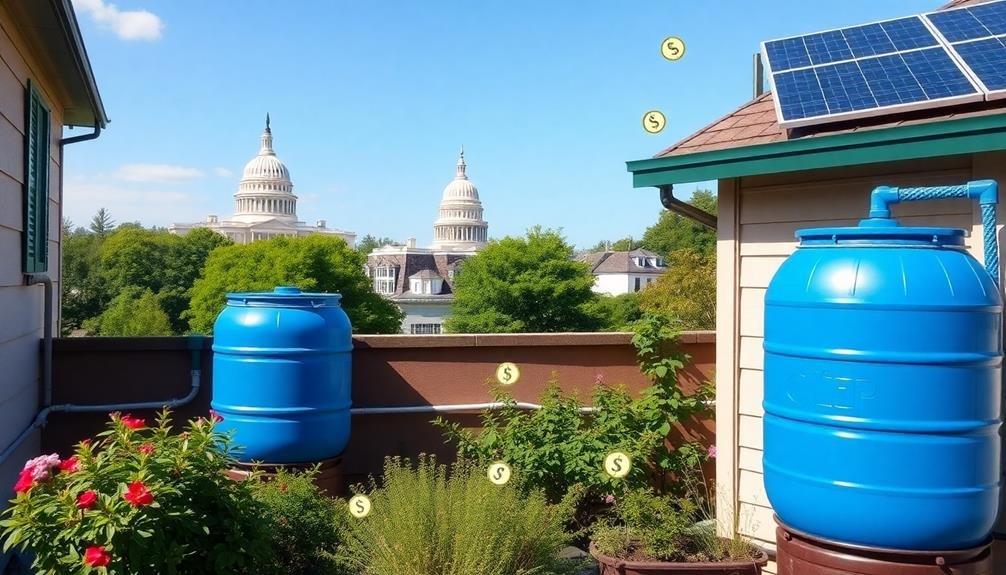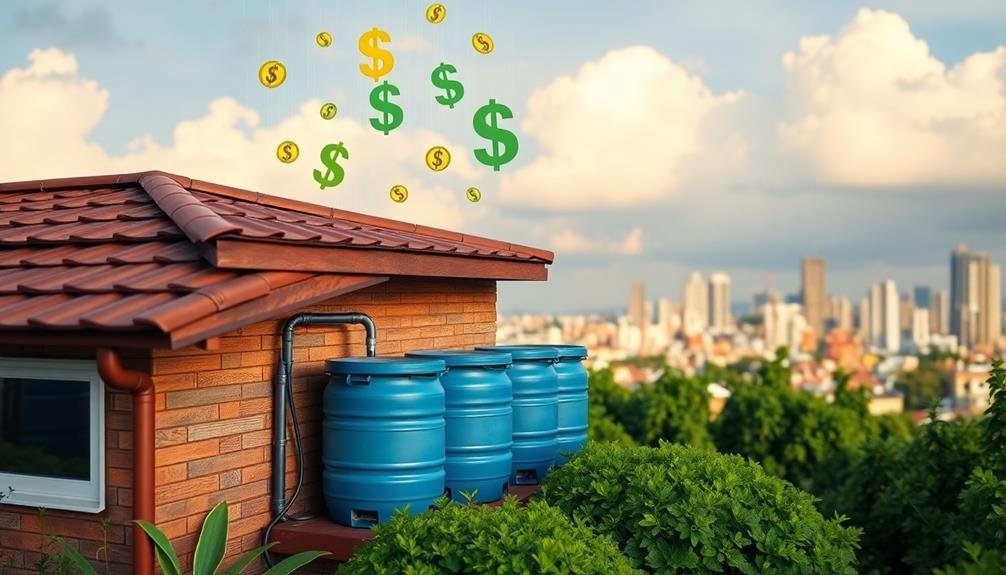You'll find several tax incentives to make rainwater harvesting more affordable. Federal tax credits offer a 30% rebate on qualified equipment and installation costs. Many states provide rebate programs with cash incentives or additional tax credits. You might qualify for property tax exemptions, reducing your annual tax bill. Some areas offer sales tax exemptions on system purchases. Income tax deductions can lower your taxable income based on system costs. Municipal grants and subsidies may partially reimburse installation expenses. Businesses can benefit from accelerated depreciation, improving cash flow in early years. Exploring these options could greatly offset your investment in sustainable water management.
Federal Tax Credits

Homeowners looking to save on their taxes while conserving water may find relief in federal tax credits for rainwater harvesting systems. These credits can considerably reduce the cost of installing and maintaining a rainwater collection system on your property.
The federal government offers a 30% tax credit for qualified rainwater harvesting equipment through the Residential Renewable Energy Tax Credit program. This credit applies to the total cost of the system, including installation expenses.
To qualify, your system must be used for residential purposes and meet specific efficiency standards set by the Environmental Protection Agency.
You'll need to file IRS Form 5695 with your tax return to claim the credit. Keep all receipts and documentation related to your rainwater harvesting system purchase and installation. The credit is non-refundable, meaning it can only reduce your tax liability to zero, but any unused portion can be carried forward to future tax years.
Be aware that these tax credits are subject to change, so it's vital to check the most current IRS guidelines or consult a tax professional before making your purchase.
State-Level Rebate Programs
Many states across the U.S. offer their own rebate programs to encourage rainwater harvesting, complementing federal tax incentives. These programs vary widely in their structure and benefits, so you'll need to check your state's specific offerings.
Some states provide direct cash rebates for installing rainwater collection systems, while others offer tax credits or deductions on your state income tax return.
You'll find that rebate amounts can range from a few hundred dollars to several thousand, depending on the system's size and complexity. Some programs have tiered structures, offering higher rebates for larger or more efficient systems.
To qualify, you'll typically need to meet certain criteria, such as minimum storage capacity or specific system components.
Don't forget to look into local incentives as well. Many cities and counties have their own rebate programs, which you can often combine with state-level offers.
To maximize your benefits, you should research all available options in your area. Keep in mind that these programs may have limited funding, so it's wise to apply early in the fiscal year to guarantee you don't miss out on potential savings.
Property Tax Exemptions

Property tax exemptions can greatly reduce your financial burden when installing a rainwater harvesting system.
You'll find that many jurisdictions offer a reduction in the assessed value of your property, which directly lowers your annual property tax bill.
These exemptions often last for several years, allowing you to recoup your investment over time while promoting sustainable water management practices.
Assessment Value Reduction
Assessment value reduction offers a compelling incentive for property owners to invest in rainwater harvesting systems. This approach allows you to decrease the assessed value of your property, specifically for the portion related to the rainwater harvesting installation. As a result, you'll pay lower property taxes while reaping the benefits of sustainable water management.
To take advantage of this incentive, you'll need to contact your local tax assessor's office and inquire about their assessment value reduction program for rainwater harvesting systems. You may be required to provide documentation of your system's costs, specifications, and expected water savings.
Once approved, the assessor will recalculate your property's value, subtracting a portion of the rainwater harvesting system's cost from the overall assessment. The amount of reduction varies by jurisdiction, but it can be significant. Some areas offer a dollar-for-dollar reduction, while others provide a percentage-based decrease.
Duration of Exemptions
Typically, the duration of property tax exemptions for rainwater harvesting systems varies by jurisdiction. You'll find that some areas offer these incentives for a limited time, while others provide ongoing benefits. It's important to check with your local tax assessor's office for specific details about the exemption period in your area.
When considering the duration of these exemptions, keep in mind that they may be:
- Fixed-term: Set for a specific number of years (e.g., 5 or 10 years)
- Renewable: Eligible for extension after the initial period expires
- Permanent: Lasting as long as the system remains functional
- Conditional: Dependent on system maintenance or performance criteria
You should also be aware that the exemption duration might be tied to the expected lifespan of the rainwater harvesting system. Some jurisdictions may require periodic inspections or certifications to maintain the exemption status.
It's vital to understand these requirements to guarantee you can maximize the tax benefits for your investment in a rainwater harvesting system. Remember that tax laws can change, so stay informed about any updates or modifications to the exemption duration in your area.
Sales Tax Exemptions
Several states have implemented sales tax exemptions to encourage the adoption of rainwater harvesting systems. These exemptions can greatly reduce the upfront costs of purchasing and installing such systems, making them more accessible to homeowners and businesses alike.
You'll find that states like Texas, Virginia, and Rhode Island offer sales tax exemptions on rainwater harvesting equipment. In Texas, for example, you won't pay sales tax on tanks, pumps, filters, and other components specifically designed for rainwater collection. Virginia's exemption covers equipment used for storing or reusing rainwater, while Rhode Island exempts water conservation devices, including rainwater harvesting systems.
To take advantage of these exemptions, you'll usually need to fill out a form or provide documentation proving that the equipment will be used for rainwater harvesting. Some states may require certification from a professional installer or a detailed description of your planned system.
It's important to note that these exemptions may have limitations. They might only apply to certain types of equipment or have maximum purchase amounts. Always check your state's specific requirements and consult with a tax professional to verify you're fully complying with the exemption guidelines.
Income Tax Deductions

You'll find various income tax deductions available for installing rainwater harvesting systems, with amounts typically based on the system's cost and capacity.
To qualify, your system must meet specific requirements, such as minimum storage capacity and compliance with local building codes.
When claiming these deductions, you'll need to provide thorough documentation, including receipts, system specifications, and installation details.
Available Deduction Amounts
While the specific deduction amounts for rainwater harvesting systems vary by jurisdiction, many regions offer substantial tax incentives to encourage adoption.
You'll find that deductions can range from a few hundred to several thousand dollars, depending on the size and complexity of your system.
In some areas, you might be eligible for a percentage-based deduction, typically ranging from 10% to 30% of the total installation cost. Other jurisdictions offer fixed deduction amounts based on system capacity or specific components.
It's crucial to check with your local tax authority or a tax professional to determine the exact deductions available in your area.
Common factors influencing deduction amounts include:
- System capacity (gallons or liters)
- Type of collection surface (roof, ground, etc.)
- Filtration and treatment methods
- Intended use (irrigation, potable water, etc.)
You'll often find that larger, more thorough systems qualify for higher deductions.
Additionally, some regions offer tiered deduction structures, allowing you to claim multiple incentives for different aspects of your rainwater harvesting system.
Remember to keep detailed records of your expenses and system specifications to maximize your eligible deductions.
Qualifying System Requirements
Eligibility for rainwater harvesting tax incentives hinges on meeting specific system requirements set by tax authorities. To qualify, your system must be designed primarily for collecting and storing rainwater for non-potable uses. It should include a catchment area, such as your roof, gutters and downspouts to direct water, and a storage tank or cistern.
Your system must have a minimum storage capacity, typically 500 gallons, though this may vary by jurisdiction. It should also incorporate filtration methods to remove debris and contaminants. Many areas require the installation of a first-flush diverter to eliminate initial runoff containing higher levels of pollutants.
You'll need to guarantee proper system maintenance and keep detailed records of installation costs, including materials and labor. Some regions may require professional installation or certification to qualify for tax incentives.
Additionally, your system should comply with local building codes and zoning regulations. It's essential to check with your local tax office or a tax professional for specific requirements in your area, as they can vary considerably between jurisdictions.
Documentation for Claims
Claiming tax deductions for rainwater harvesting systems requires meticulous documentation. You'll need to gather and organize specific information to support your claim. The Internal Revenue Service (IRS) may request these documents during an audit, so it's essential to maintain accurate records.
To facilitate a smooth claiming process, you should collect and keep the following:
- Detailed receipts or invoices for all system components and installation costs
- Manufacturer's certification stating the system meets efficiency standards
- Photos of the installed system, including before and after installation shots
- A written statement from a qualified professional confirming proper installation
You'll also need to complete the appropriate tax forms, typically Form 5695 for residential energy credits. Be sure to accurately report the total cost of your system and calculate the eligible credit amount.
Keep all documentation for at least three years after filing your tax return, as this is the standard IRS audit window. If you're unsure about any aspect of the documentation process, it's wise to consult a tax professional who specializes in energy-efficient home improvements. They can guide you through the complexities of claiming these valuable tax incentives.
Municipal Grants and Subsidies
How can local governments encourage rainwater harvesting? Many municipalities offer grants and subsidies to incentivize residents and businesses to install rainwater harvesting systems. These financial incentives can greatly offset the initial costs of implementation, making it more attractive for property owners to adopt sustainable water management practices.
You'll find various types of municipal support available, depending on your location. Here's a quick overview of common incentives:
| Grant Type | Description |
|---|---|
| Installation Rebate | Partial reimbursement for system installation costs |
| Equipment Subsidy | Discounts on rainwater harvesting equipment |
| Property Tax Credit | Reduction in annual property taxes |
| Stormwater Fee Discount | Lower fees for reducing runoff |
| Water Bill Credit | Reduced water bills for decreased municipal water use |
To take advantage of these incentives, you'll need to research your local government's offerings. Contact your city's water department or environmental agency for specific information on available programs. Remember, these incentives are often limited, so act quickly to secure funding for your rainwater harvesting project.
Accelerated Depreciation Benefits

Beyond direct subsidies, you'll find that accelerated depreciation benefits can greatly boost the financial appeal of rainwater harvesting systems. These tax incentives allow you to deduct a larger portion of your investment in the early years of the system's life, reducing your taxable income and providing immediate financial relief.
When you opt for accelerated depreciation, you'll enjoy several advantages:
- Faster recovery of your initial investment
- Improved cash flow in the short term
- Reduced tax liability in the early years
- Enhanced return on investment calculations
You'll typically use the Modified Accelerated Cost Recovery System (MACRS) for rainwater harvesting equipment. Under MACRS, you can depreciate most systems over a 5-year period, with a larger percentage deductible in the first few years.
This front-loaded approach means you'll see more significant tax savings early on, offsetting the initial installation costs.
It's important to note that while accelerated depreciation offers immediate benefits, you'll have smaller deductions in later years. You should consult a tax professional to determine how this strategy fits into your overall financial plan and to guarantee you're complying with current tax laws and regulations.
Frequently Asked Questions
How Long Does It Take to Recover the Cost of Installing a Rainwater Harvesting System?
You'll typically recover the cost of installing a rainwater harvesting system within 3-5 years. However, it can vary depending on your location, system size, water usage, and local water rates. Regular maintenance guarantees peak performance.
Are There Any Restrictions on the Size of Rainwater Harvesting Systems for Incentives?
You'll find that restrictions on system size for incentives vary by location. Some areas limit capacity, while others don't. It's best to check with your local government or water authority for specific guidelines in your region.
Can I Combine Multiple Tax Incentives for My Rainwater Harvesting System?
You can often combine multiple tax incentives for your rainwater harvesting system. It's best to check with your local tax professional or government office, as rules may vary depending on your location and specific circumstances.
Do Tax Incentives Apply to Both Residential and Commercial Rainwater Harvesting Systems?
You'll find that tax incentives often apply to both residential and commercial rainwater harvesting systems. However, it's essential to check your local regulations, as specific incentives and eligibility criteria can vary depending on your location and system type.
What Maintenance Requirements Must Be Met to Maintain Eligibility for Tax Incentives?
You'll need to regularly clean filters, inspect tanks, and maintain gutters. Don't forget to check for leaks and repair any damage promptly. Keep detailed maintenance records to prove you're meeting requirements and staying eligible for incentives.
In Summary
You've got plenty of options to save money when installing a rainwater harvesting system. From federal tax credits to local grants, these incentives can greatly reduce your costs. Don't forget to check for state and municipal programs that might offer additional savings. By taking advantage of these tax breaks and financial perks, you're not only conserving water but also keeping more cash in your pocket. It's a win-win for your wallet and the environment.





Leave a Reply